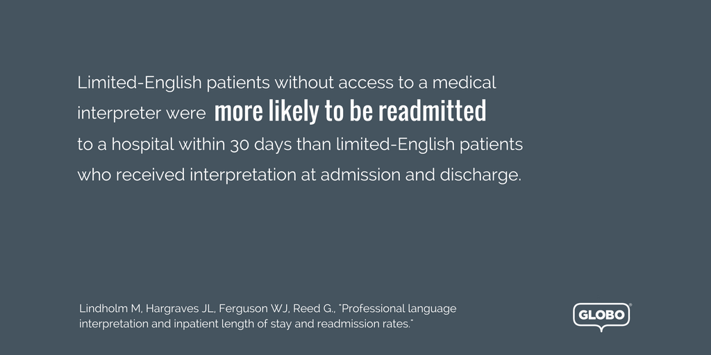Stay up to date.
Stay connected with tips, resources & stories on language access.

Risk isn’t just a strategy board game. It's a guiding principle in reaching conclusions and making decisions. Nowhere is the need to identify and quantify risk clearer than in healthcare.
Patients and medical professionals work hand-in-hand to identify health histories and risk factors as they develop care plans. Clinicians and data experts rely on patients’ medical histories and habits to develop what are known as risk pools, which help healthcare providers understand their patient populations and spend resources most effectively. It’s a process called risk stratification.
But what happens when a language barrier hinders doctor-patient communication? Lapses in communication can limit healthcare access and harm risk pools’ accuracy. However, healthcare systems can partner with a language services provider to strengthen communication between limited-English patients and medical staff, and safeguard the accuracy of risk pools and improve patient care.
In this post, I’ll explain risk stratification, and then demonstrate why language services, such as telephone interpreting, must be a central tenet of risk determination and patient interaction.
Classic risk stratification models segment patients into risk groups (high, low and rising-risk), based on each individual patient’s medical history and current lifestyle. For example, heart failure patients must be grouped into the correct stratification pool based on their risk of readmission. These risk pools, when aggregated, create a snapshot of a population’s health, i.e. every member of a healthcare provider’s network. Medical professionals use risk stratification groups to optimize care, effectively manage resources and promote better health outcomes.
Medical professionals also monitor patients within each subgroup for individual-specific risk factors. Then, doctors and patients can craft specialized treatment plans to ensure individuals don’t jump to a higher risk group.
However, the foundation of risk stratification rests on two critical assumptions: Patients can convey their current health and medical history to a doctor or nurse, and medical personnel can understand what their patients are saying.
As part of risk stratification, as well as patient-centered care, medical professionals prescribe treatments based on a patient’s lifestyle and current medical condition. However, treatment plans--no matter how thoughtfully planned--are ineffective, and potentially risky, when communication breakdowns occur between limited-English speakers and their doctors.
A 2005 study revealed Limited English Proficient patients without access to a qualified medical interpreter or a language-concordant physician are at greater risk of adverse medication reactions. Another study found that compared to patients who communicated through an interpreter, limited-English patients without access to a medical interpreter were more likely to be readmitted to a hospital within 30 days. Communication failures like these result in worse health outcomes and frequent, costly return visits to the ER.

Professional language services, including telephone, video remote and on-site interpreting, ensure a line of clear and accurate communication between clinicians and patients. By working with qualified medical interpreters to facilitate interactions with limited-English patients, physicians can better understand their patients’ health needs, prescribe appropriate care, schedule follow-ups, and ensure their patients comprehend their own healthcare plan.
Of course, risk stratification revolves around data--the more data actuaries and medical personnel crunch, the more accurate risk pools they’ll produce.
 Researchers must collect data on every patient to paint a holistic picture of the entirety of their health system’s population. Unfortunately, some risk stratification programs used by doctors don't merge patient data into a single table, meaning that not all of a health system's patient data can be found in one, organized place. And when communication breakdowns occur between limited-English speakers and medical professionals, patient data sets wind up incomplete and diminish the accuracy of risk pools.
Researchers must collect data on every patient to paint a holistic picture of the entirety of their health system’s population. Unfortunately, some risk stratification programs used by doctors don't merge patient data into a single table, meaning that not all of a health system's patient data can be found in one, organized place. And when communication breakdowns occur between limited-English speakers and medical professionals, patient data sets wind up incomplete and diminish the accuracy of risk pools.
Healthcare systems must use tools, and rely on partners, that can coalesce data points from every patient into comprehensive, actionable healthcare data tables. By partnering with a data-forward language services provider, healthcare organizations can capture valuable data about Limited English Proficient patients while also enabling better healthcare interactions.
The goals of risk pools are indeed worthwhile: improve health outcomes, reduce readmission rates and effectively manage resources and care. All of those goals are attainable, but only if health systems stratify pools based on comprehensive data sets.
Medical professionals utilizing the highest-quality data can more accurately assign risk pools, and prevent patients from escalating into higher risk pools. By working with a language services provider, health systems can work with medical interpreters to effectively communicate with their limited-English population and capture important information around their current health status, including pre-existing conditions. From there, medical professionals can provide the best treatment plans possible, while ensuring their limited-English patients comprehend their diagnosis and understand their at-home aftercare. Professional language services promote better patient-provider communication, aid in accurate risk stratification and ultimately improve health outcomes.
Risk stratification is built on data. Effective language services are, too.